FEATURE ARTICLE - Children living without an employed parent
FEATURE ARTICLE - Labour Force Survey Regions
FEATURE ARTICLE - Spotlight on Industrial Disputes
FEATURE ARTICLE - Labour Underutilisation
NOTES
CHANGES IN THIS ISSUE
The Labour Market Summary table now contains all five annual labour underutilisation rates. Table 4.1 has also been revised, with the addition of the underemployment rate.
DATA CONTAINED IN THIS ISSUE
The statistics shown are the latest available at 24 June 2004. Data sources for the tables in this publication are listed in Appendix 1.
ELECTRONIC PRODUCTS
The spreadsheets and data cubes referenced in this publication are available on the ABS web site. To find them, go to the home page and follow the links to Data cubes and Time Series Spreadsheets.
INQUIRIES
For further information about these and related statistics, contact the National Information and Referral Service on 1300 135 070 or Tracey Chester on Canberra (02) 6252 7636.
For email enquiries, please contact Client Services on client.services@abs.gov.au.
LABOUR MARKET SUMMARY
KEY MEASURES
 |  |  |  |  |  | % change from
|  |
| Measure | Series type | Period | Current figure | Previous quarter(a) | Previous year(b) |  |
|  |
| Employed |  |  |  |  |  |  |  |
 | Persons | '000 | Trend | May 2004 | 9,669.5 | 0.7 | 2.4 |  |
 | Full-time | '000 | Trend | May 2004 | 6,913.5 | 0.6 | 2.8 |  |
 | Part-time | '000 | Trend | May 2004 | 2,756.0 | 0.9 | 1.4 |  |
 | Part-time employment as a proportion of total employment | % | Trend | May 2004 | 28.5 | (c)0.1 | (c)-0.3 |  |
| Unemployed |  |  |  |  |  |  |  |
 | Persons | '000 | Trend | May 2004 | 569.3 | -2.0 | -8.8 |  |
 | Looking for full-time work | '000 | Trend | May 2004 | 420.7 | -0.8 | -9.9 |  |
 | Looking for part-time work | '000 | Trend | May 2004 | 148.6 | -5.0 | -5.6 |  |
| Unemployment rate |  |  |  |  |  |  |  |
 | Persons | % | Trend | May 2004 | 5.6 | (c)-0.1 | (c)-0.6 |  |
| Long-term unemployment |  |  |  |  |  |  |  |
 | Persons | '000 | Trend | May 2004 | 117.8 | -2.7 | -11.9 |  |
 | As a proportion of total unemployment | % | Trend | May 2004 | 20.7 | (c)-0.2 | (c)-0.7 |  |
| Annual labour underutilisation rates(d) |  |  |  |  |  |  |  |
 | Long-term unemployment rate | % | Original | Sep 2003 | 1.3 | na | (c)-0.1 |  |
 | Unemployment rate | % | Original | Sep 2003 | 5.9 | na | (c)-0.5 |  |
 | Underemployment rate | % | Original | Sep 2003 | 5.6 | na | (c)-0.2 |  |
 | Labour force underutilisation rate | % | Original | Sep 2003 | 11.5 | na | (c)-0.6 |  |
 | Extended labour force underutilisation rate | % | Original | Sep 2003 | 12.5 | na | (c)-0.7 |  |
| Children living in families where no parent is employed(e) | % | Original | Jun 2003 | 17.2 | na | (c)-0.7 |  |
| Labour force participation rate |  |  |  |  |  |  |  |
 | Persons | % | Trend | May 2004 | 63.7 | (c)0.1 | (c)0.1 |  |
| Actual hours worked |  |  |  |  |  |  |  |
 | Aggregate weekly hours | mill. hours | Original | May 2004 | 334.0 | -0.7 | 2.0 |  |
 | Average weekly hours - Persons | hours | Original | May 2004 | 34.6 | -1.8 | 0.0 |  |
 | Average weekly hours - Full-time | hours | Original | May 2004 | 42.0 | -0.8 | -0.2 |  |
 | Average weekly hours - Part-time | hours | Original | May 2004 | 16.5 | -2.3 | 0.7 |  |
| Part-time workers |  |  |  |  |  |  |  |
 | Proportion who preferred to work more hours | % | Original | May 2004 | 25.7 | (c)-0.8 | (c)0.1 |  |
| Wage cost index |  |  |  |  |  |  |  |
 | Total hourly rates of pay excluding bonuses | index no. | Trend | Mar qtr 2004 | 123.7 | 0.9 | 3.7 |  |
| Average weekly earnings |  |  |  |  |  |  |  |
 | Full-time adult ordinary time earnings | $ | Trend | Feb 2004 | 948.00 | 1.0 | 4.9 |  |
 | All employees total earnings | $ | Trend | Feb 2004 | 752.30 | 1.2 | 5.3 |  |
| Compensation of employees |  |  |  |  |  |  |  |
 | Household income account | $m | Trend | Mar qtr 2004 | 95,411 | 1.4 | 5.4 |  |
 | Average earnings (National Accounts basis - nominal) per week | $ | Trend | Mar qtr 2004 | 896 | 0.9 | 3.9 |  |
| Industrial disputes |  |  |  |  |  |  |  |
 | Working days lost | '000 | Original | Mar qtr 2004 | 76.8 | -49.3 | 15.9 |  |
 | Working days lost per 1,000 employees | number | Original | Mar qtr 2004 | 9.3 | -49.7 | 14.7 |  |
| Job vacancies |  |  |  |  |  |  |  |
 | Australia | '000 | Trend | Feb 2004 | 105.5 | 0.8 | 0.0 |  |
|  |
| na not available |
| (a) Same period previous quarter (monthly data is presented for the middle month of each quarter). |
| (b) Same period previous year. |
| (c) Change is in percentage points. |
| (d) See table 4.1 or the Glossary for further explanation of labour underutilisation rates. |
| (e) As a proportion of all children aged under 15 years. See the Explanatory Notes for information on family data. |
EMPLOYMENT: TREND SERIES
Full-time and total employment
 Males and females
Males and females
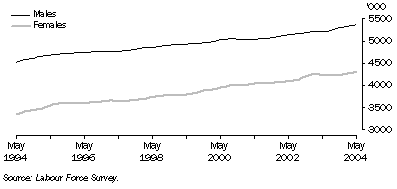
PART-TIME EMPLOYMENT: TREND SERIES
Proportion of total employment, Males
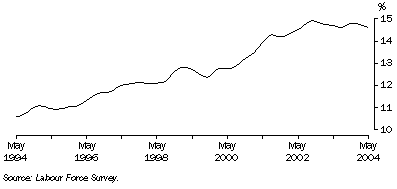 Proportion of total employment, Females
Proportion of total employment, Females
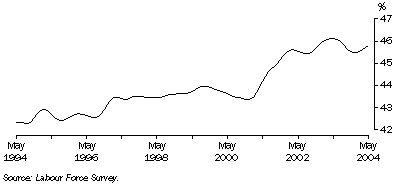
UNEMPLOYMENT RATE: TREND SERIES
Males and females
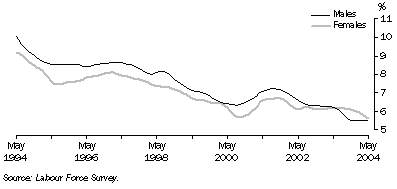
LONG-TERM UNEMPLOYMENT: TREND SERIES
Proportion of total unemployment

UNDERUTILISED LABOUR
Labour underutilisation rates - 1994-2003
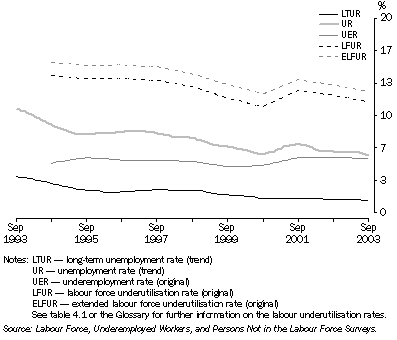
PARTICIPATION RATE: TREND SERIES
WAGE COST INDEX: TREND SERIES
Total hourly rates of pay excluding bonuses, Quarterly change
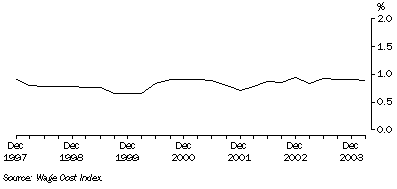
AVERAGE WEEKLY EARNINGS: TREND SERIES
Full-time adult ordinary time earnings, Quarterly change
 All employees total earnings, Level
All employees total earnings, Level
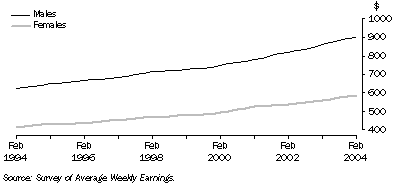
INDUSTRIAL DISPUTES: ORIGINAL SERIES
Working days lost, Quarter ending

JOB VACANCIES: TREND SERIES
Job Vacancies, By sector
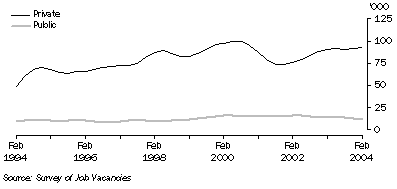
LABOUR STATISTICS NEWS
LABOUR THEME PAGE
The ABS Labour Theme Page, available on the ABS web site, provides a guide to the range of ABS statistics on the labour market, as well as links to the latest data released. To find the Theme Page, go to the ABS home page and click on Themes and then Labour.
ABS EMAIL NOTIFICATION SERVICE
By subscribing to this free service, you will be kept informed via email of the latest releases of ABS products. To subscribe, follow the link from the ABS home page, provide your email address, and select your topics of interest.
IMPLEMENTATION OF COMPUTER ASSISTED INTERVIEWING
In October 2003, the ABS began the progressive implementation of computer assisted interviewing (CAI) into the LFS. For the period October 2003 to January 2004, CAI was used on a random 10% sub-sample of interviews. The proportion of survey interviews conducted using CAI has since increased to 40% across Australia in April and May 2004, and 70% in June 2004.
Implementation of CAI is not expected to affect published estimates in any meaningful way. Nonetheless, the ABS is monitoring the situation carefully and has conducted a range of analyses on each month's data. These analyses have confirmed that any effect that the change in interview method may have had on survey responses to date has not materially affected labour force estimates for any month.
NATIONAL STATISTICAL SERVICE WEBSITE
The National Statistical Service (NSS) is an ABS-led initiative which supports the whole of government approach to the management of statistical information. As part of this initiative, a new web site <http://www.nss.gov.au> has been released to assist agencies in applying sound statistical and data management principles and practices. The web site provides a core set of resources, including:
- NSS Handbook and Key Principles (providing an overview of the statistical process for collection managers, designers, or users of statistical products)
- directories of statistical sources
- published Information Development Plans
- statistical training offered by government agencies
- papers on statistical best practice
- concepts, classifications and data dictionaries.
NATIONAL ABORIGINAL AND TORRES STRAIT ISLANDER SOCIAL SURVEY
The results of the second national social survey of Indigenous people were released on 23 June 2004 in National Aboriginal and Torres Strait Islander Social Survey, 2002 (cat. no. 4714.0). This survey was designed to enable analysis of the inter-relationship of social circumstances and outcomes that may be experienced by Aboriginal and Torres Strait Islander Australians. Work is one of the broad topic groups that has been covered, and the survey enabled separate identification of work through the Community Development Employment Projects (CDEP) scheme.
INDUSTRIAL DISPUTES STATISTICS
A number of changes to the release of industrial disputes statistics were introduced with the release of Industrial Disputes, Australia (Electronic Publication) (cat. no. 6321.0.55.001) for the March quarter 2004 on 17 June 2004, including a move from a monthly to a quarterly release. These changes follow a review of the Industrial Disputes collection, and consultation with users. More information is available in the short article on Industrial Disputes statistics included in the spotlight section of this publication, and through the link on the Labour Theme Page.
MAJOR LABOUR COSTS
The 2002-03 Major Labour Costs survey provides statistics on the main costs incurred by private and public sector organisations as a consequence of employing labour. The survey collected data on the following labour costs for the financial year 2002-03: employee earnings (net of reimbursements from government); superannuation; payroll tax; workers compensation; and fringe benefits tax.
Survey results were released on 11 June 2004 in Labour Costs, Australia (cat. no. 6348.0.55.001), an electronic publication available free of charge on the ABS web site. An article on the survey results is included in the recent release section of this publication.
SUPPLEMENTARY SURVEYS ON LABOUR TOPICS
The Monthly Population Survey comprises the Labour Force Survey and a number of supplementary surveys, which provide detailed information on a range of topics. Results from surveys on labour-related topics recently released include Working Arrangements, Australia (cat. no. 6342.0), and Characteristics of Small Business, Australia (cat. no. 8127.0). These releases are outlined in the recent release section of this publication.
Recent and upcoming statistical releases |
|  |
| Release date/title of publication | Reference period | Catalogue number |  |
|  |
| June 2004 |  |  |  |
 | Industrial Disputes, Australia (Electronic Publication) | March quarter 2004 | 6321.0.55.001 |  |
 | Labour Costs, Australia | 2002-03 | 6348.0.55.001 |  |
 | Labour Force, Australia | May 2004 | 6202.0 |  |
 | Labour Force, Australia - Detailed Delivery | May 2004 | 6291.0.55.001 |  |
 | National Aboriginal and Torres Strait Islander Social Survey | 2002 | 4714.0 |  |
 | Wage and Salary Earners, Public Sector, Australia | March quarter 2004 | 6248.0.55.001 |  |
 | Working Arrangements, Australia | November 2003 | 6342.0 |  |
| July 2004 |  |  |  |
 | Australian Labour Market Statistics | July 2004 | 6105.0 |  |
 | Family Characteristics | June 2003 | 4442.0 |  |
 | Job Vacancies, Australia | May 2004 | 6354.0 |  |
 | Labour Force, Australia | June 2004 | 6202.0 |  |
 | Labour Force, Australia - Detailed Delivery | June 2004 | 6291.0.55.001 |  |
 | Occasional Paper: Perspectives on Women's Employment in Regional Australia, 2001 Census | 2001 | 1380.0.55.001 |  |
| August 2004 |  |  |  |
 | Average Weekly Earnings, Australia | May 2003 | 6302.0 |  |
 | Labour Force, Australia | July 2004 | 6202.0 |  |
 | Labour Force, Australia - Detailed Delivery | July 2004 | 6291.0.55.001 |  |
 | Labour Mobility | February 2004 | 6209.0 |  |
 | Wage Cost Index, Australia | June quarter 2004 | 6345.0 |  |
| September 2004 |  |  |  |
 | Household Income and Income Distribution, Australia | 2002-03 | 6523.0 |  |
 | Industrial Disputes, Australia | June quarter 2004 | 6321.0.55.001 |  |
 | Information Paper: Persons in Own Business, Experimental Estimates for Small Areas | 1996-97 to 2000-01 | 6225.0 |  |
 | Job Vacancies, Australia | August 2004 | 6354.0 |  |
 | Labour Force, Australia | August 2004 | 6202.0 |  |
 | Labour Force, Australia - Detailed Delivery | August 2004 | 6291.0.55.001 |  |
 | Wage and Salary Earners, Public Sector, Australia | June quarter 2004 | 6248.0.55.001 |  |
| October 2004 |  |  |  |
 | Australian Labour Market Statistics | October 2004 | 6105.0 |  |
 | Labour Force, Australia | September 2004 | 6202.0 |  |
 | Labour Force, Australia - Detailed Delivery | September 2004 | 6291.0.55.001 |  |
|  |
 Print Page
Print Page
 Print All
Print All